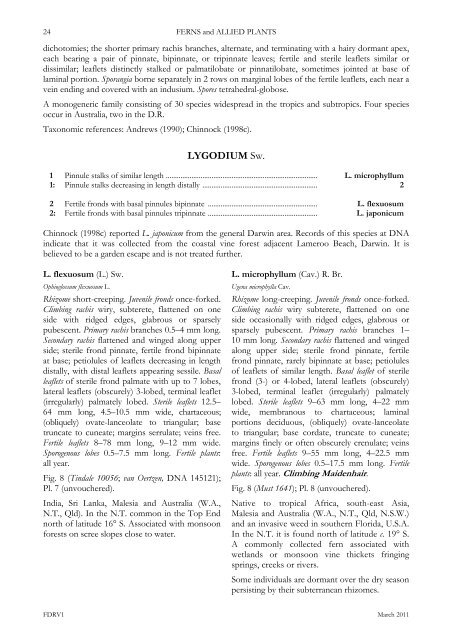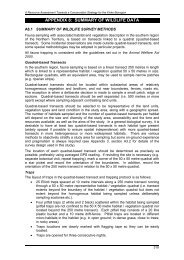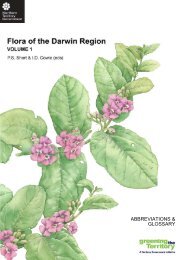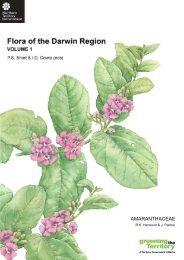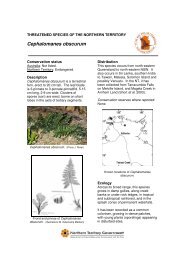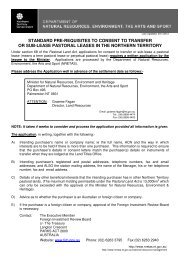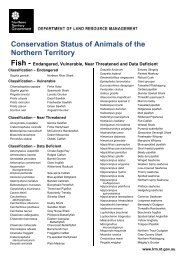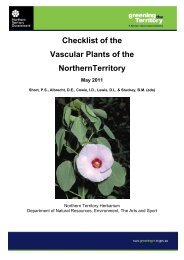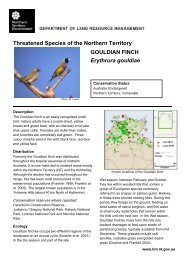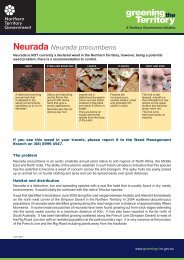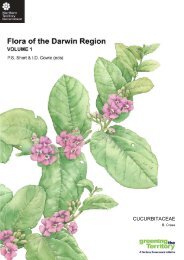ferns and allied plants - Department of Land Resource Management ...
ferns and allied plants - Department of Land Resource Management ...
ferns and allied plants - Department of Land Resource Management ...
You also want an ePaper? Increase the reach of your titles
YUMPU automatically turns print PDFs into web optimized ePapers that Google loves.
24<br />
FERNS <strong>and</strong> ALLIED PLANTS<br />
dichotomies; the shorter primary rachis branches, alternate, <strong>and</strong> terminating with a hairy dormant apex,<br />
each bearing a pair <strong>of</strong> pinnate, bipinnate, or tripinnate leaves; fertile <strong>and</strong> sterile leaflets similar or<br />
dissimilar; leaflets distinctly stalked or palmatilobate or pinnatilobate, sometimes jointed at base <strong>of</strong><br />
laminal portion. Sporangia borne separately in 2 rows on marginal lobes <strong>of</strong> the fertile leaflets, each near a<br />
vein ending <strong>and</strong> covered with an indusium. Spores tetrahedral-globose.<br />
A monogeneric family consisting <strong>of</strong> 30 species widespread in the tropics <strong>and</strong> subtropics. Four species<br />
occur in Australia, two in the D.R.<br />
Taxonomic references: Andrews (1990); Chinnock (1998c).<br />
LYGODIUM Sw.<br />
1 Pinnule stalks <strong>of</strong> similar length ................................................................................... L. microphyllum<br />
1: Pinnule stalks decreasing in length distally ............................................................... 2<br />
2 Fertile fronds with basal pinnules bipinnate ............................................................ L. flexuosum<br />
2: Fertile fronds with basal pinnules tripinnate ............................................................ L. japonicum<br />
Chinnock (1998c) reported L. japonicum from the general Darwin area. Records <strong>of</strong> this species at DNA<br />
indicate that it was collected from the coastal vine forest adjacent Lameroo Beach, Darwin. It is<br />
believed to be a garden escape <strong>and</strong> is not treated further.<br />
L. flexuosum (L.) Sw.<br />
Ophioglossum flexuosum L.<br />
Rhizome short-creeping. Juvenile fronds once-forked.<br />
Climbing rachis wiry, subterete, flattened on one<br />
side with ridged edges, glabrous or sparsely<br />
pubescent. Primary rachis branches 0.5–4 mm long.<br />
Secondary rachis flattened <strong>and</strong> winged along upper<br />
side; sterile frond pinnate, fertile frond bipinnate<br />
at base; petiolules <strong>of</strong> leaflets decreasing in length<br />
distally, with distal leaflets appearing sessile. Basal<br />
leaflets <strong>of</strong> sterile frond palmate with up to 7 lobes,<br />
lateral leaflets (obscurely) 3-lobed, terminal leaflet<br />
(irregularly) palmately lobed. Sterile leaflets 12.5–<br />
64 mm long, 4.5–10.5 mm wide, chartaceous;<br />
(obliquely) ovate-lanceolate to triangular; base<br />
truncate to cuneate; margins serrulate; veins free.<br />
Fertile leaflets 8–78 mm long, 9–12 mm wide.<br />
Sporogenous lobes 0.5–7.5 mm long. Fertile <strong>plants</strong>:<br />
all year.<br />
Fig. 8 (Tindale 10056; van Oertzen, DNA 145121);<br />
Pl. 7 (unvouchered).<br />
India, Sri Lanka, Malesia <strong>and</strong> Australia (W.A.,<br />
N.T., Qld). In the N.T. common in the Top End<br />
north <strong>of</strong> latitude 16° S. Associated with monsoon<br />
forests on scree slopes close to water.<br />
L. microphyllum (Cav.) R. Br.<br />
Ugena microphylla Cav.<br />
Rhizome long-creeping. Juvenile fronds once-forked.<br />
Climbing rachis wiry subterete, flattened on one<br />
side occasionally with ridged edges, glabrous or<br />
sparsely pubescent. Primary rachis branches 1–<br />
10 mm long. Secondary rachis flattened <strong>and</strong> winged<br />
along upper side; sterile frond pinnate, fertile<br />
frond pinnate, rarely bipinnate at base; petiolules<br />
<strong>of</strong> leaflets <strong>of</strong> similar length. Basal leaflet <strong>of</strong> sterile<br />
frond (3-) or 4-lobed, lateral leaflets (obscurely)<br />
3-lobed, terminal leaflet (irregularly) palmately<br />
lobed. Sterile leaflets 9–63 mm long, 4–22 mm<br />
wide, membranous to chartaceous; laminal<br />
portions deciduous, (obliquely) ovate-lanceolate<br />
to triangular; base cordate, truncate to cuneate;<br />
margins finely or <strong>of</strong>ten obscurely crenulate; veins<br />
free. Fertile leaflets 9–55 mm long, 4–22.5 mm<br />
wide. Sporogenous lobes 0.5–17.5 mm long. Fertile<br />
<strong>plants</strong>: all year. Climbing Maidenhair.<br />
Fig. 8 (Must 1641); Pl. 8 (unvouchered).<br />
Native to tropical Africa, south-east Asia,<br />
Malesia <strong>and</strong> Australia (W.A., N.T., Qld, N.S.W.)<br />
<strong>and</strong> an invasive weed in southern Florida, U.S.A.<br />
In the N.T. it is found north <strong>of</strong> latitude c. 19° S.<br />
A commonly collected fern associated with<br />
wetl<strong>and</strong>s or monsoon vine thickets fringing<br />
springs, creeks or rivers.<br />
Some individuals are dormant over the dry season<br />
persisting by their subterranean rhizomes.<br />
FDRV1 March 2011


